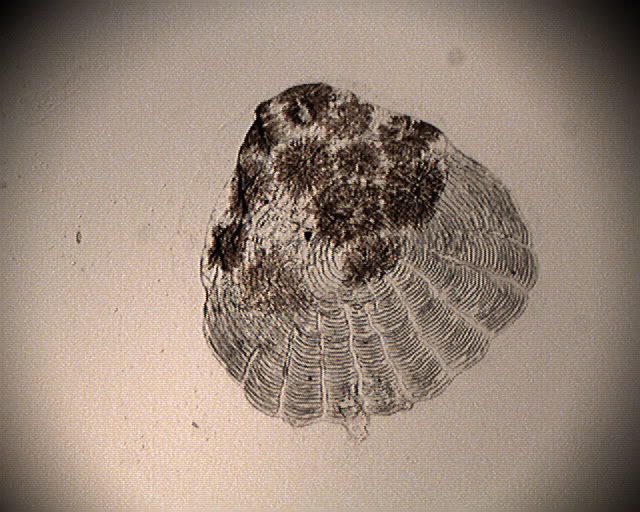I have taken an interest in looking for possible causes of death in the BSJF. I was fortunate to be given a deceased BS by RS member 30X30 for microscopic examination. Here are my findings.
This BS, like many before it, suddenly stopped eating, developed changes in skin coloration (white spots) and perished soon thereafter.
DISSCUSION
The BSJF is native to the [url=http://en.wikipedia.org/wiki/Gulf_of_California]Gulf of California - Wikipedia, the free encyclopedia[/URL] (Sea of Cortez). They are found in water 15'-150' deep and live in large colonies with each individual fish being about 4'-5' apart. They live on sandy, rubble flats near reef slopes where they build their burrows 3'-4' deep into the sea floor. They fortify the burrow by lining it with rock rubble, shells etc to keep the walls from caving in and embellish their entrance. The water temperature in the Sea of Cortez ranges from <60 degrees in the south where the Pacific Ocean meets the Gulf and >80 in the north.
The BSJF has a poor reputation for survival in captivity and much anecdotal evidence has been presented in the on-line forums. The typical presentation is the fish seems healthy for a short time, 3-6 weeks, then stops eating, develops white spots and dies rather quickly. Due to the changes in skin coloration the plight of this fish has been termed "BSJF Disease" by on-line forum goers. It's no wonder that this term has developed since the only outwardly unusual change is the development of these "white patches" or "white spots". It's more of an observational term than one that is backed by any kind of science. There are reports of long term successes with this species. However, there may be an underlying, internal disorder that is not seen as these fish are rarely, if ever dissected after death.
Many theories have been presented, but none confirmed or denied. Everything from inadequate temperature, intestinal parasites, shipping and handling stress, trauma from jumping, inadequate food source, depth of aquarium and gravel bed, you name it.
THEORY
Since this fish is a burrowing fish there is a real opportunity for it to ingest parasites, eggs of parasites, worms etc in its everyday activity of digging in the mud. In nature these internal parasites may be kept in check by the fishes natural defense system (immunity), but when they are put under stress from collection, shipping and holding, it is possible that these parasites overwhelm the fish's natural defenses and eventually leads to their demise.
TECHNIQUE
The fish was frozen for about 2 weeks, thawed and transfered to 10% buffered formalin solution for 2 weeks before dissection. The fish was dissected under a stereomicroscope. The pectoral fin was removed and four incisions were made to remove the body wall. One along the lateral line, posteriorly to the vent, anteriorly to the breast and one along the belly. The ceacum and swim bladder were removed and any connective tissue that obscured the organs.
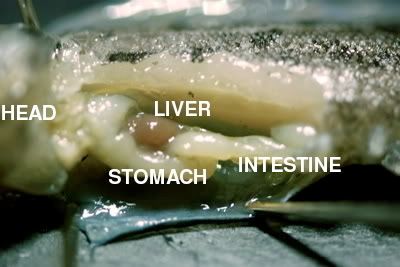
This is a picture of the stomach contents under stereomicroscope. It's full of what I believe to be mucus and small unidentified bits.
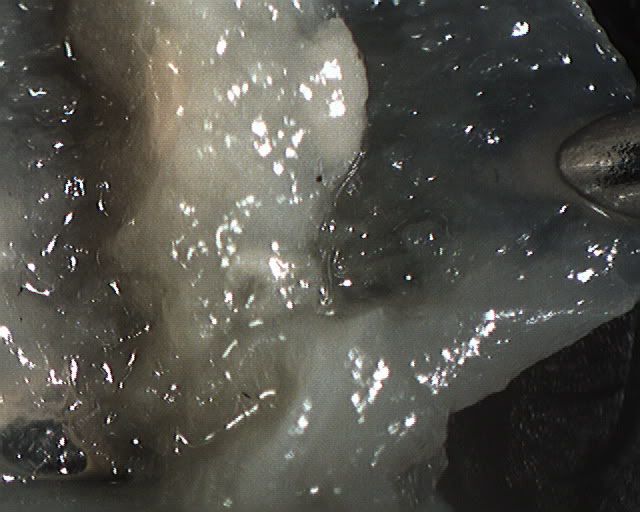
Close-up of unidentified bits.
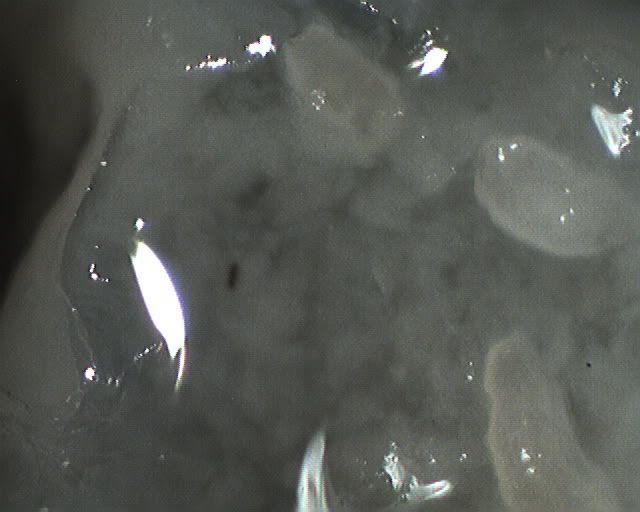
Images of the unidentified bits removed. These may well be pieces of food.


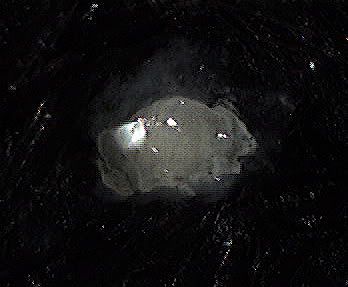
Stomach lining under stereomicroscope. Highly convoluted and muscular for churning food..
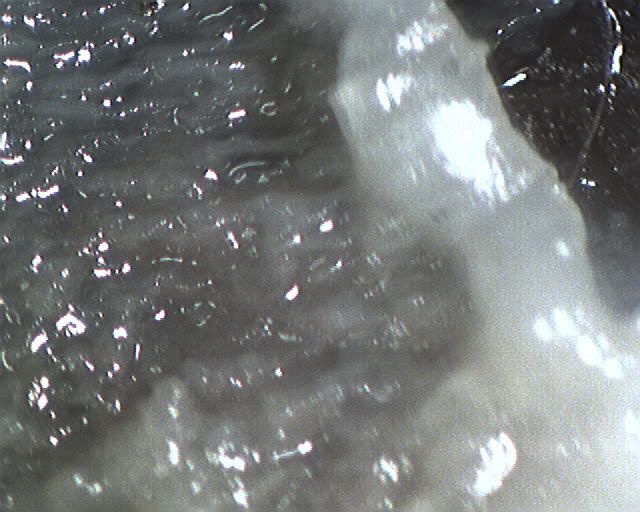
Intestinal lining under stereomicroscope. Highly convoluted for increase in surface area for nutrient absorption. The intestine was empty in this specimen, possibly due to the blockage.
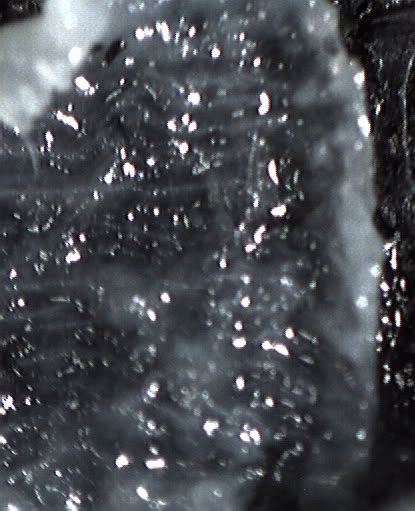
This is the intestine to the vent.
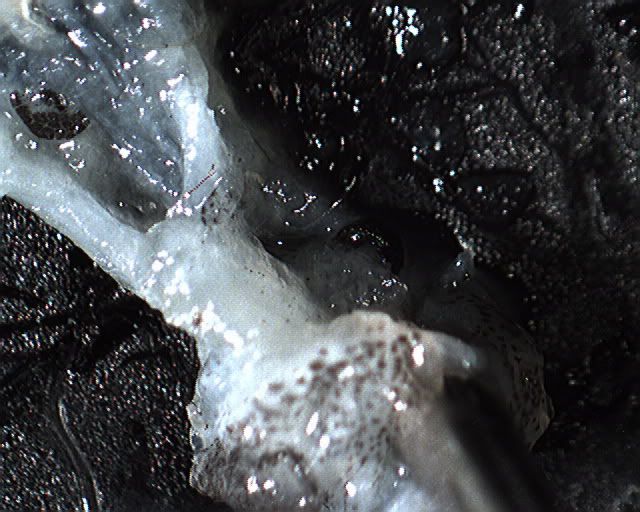
The unidentified bits were then prepared for light microscopy. I didn't find much in the way of parasites, possibly a worm, I can not confirm this, and a lot of amorphous mucus.



What I did find was pieces of sand, many of them. In fact almost all of the unidentified bits were sand covered in layers of mucus skins, kind of like an onion.

There are 2 flexures between the stomach and intestine. One from most posterior portion of the stomach turning anterior, then another turning towards the posterior into the straight intestine. It is here that I found one of these "unidentified bits" I believe there was blockage where there is a stricture or narrowing of the intestine. The intestinal lumen was empty from this point to the vent.
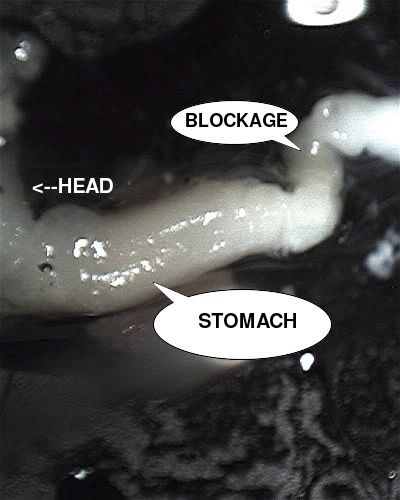
CONCLUSION
With just one dissection and microscopic exam, the presence of parasites could not be confirm or deny. There were indurated (hard) identities that were found to contain what appeared to be silicate or sand and one of them appeared to have blocked the passage of the stomach contents.
It is possible that these fish are ingesting sand with a particle size or external character that is irritating enough to cause a skinning effect or snow ball effect that these fish can not pass due to anatomical constrictions along the digestive tract. Perhaps we are not providing them the right kind of substrate? Perhaps the argonite sands are inadequate? However, without further examinations on multiple specimens none of this can be confirmed.
DISSCLAIMER
I used a quasi scientific method when presenting this thread, but is in no way meant to be the definitive answer. It is of course open to any and all criticism.
This BS, like many before it, suddenly stopped eating, developed changes in skin coloration (white spots) and perished soon thereafter.
DISSCUSION
The BSJF is native to the [url=http://en.wikipedia.org/wiki/Gulf_of_California]Gulf of California - Wikipedia, the free encyclopedia[/URL] (Sea of Cortez). They are found in water 15'-150' deep and live in large colonies with each individual fish being about 4'-5' apart. They live on sandy, rubble flats near reef slopes where they build their burrows 3'-4' deep into the sea floor. They fortify the burrow by lining it with rock rubble, shells etc to keep the walls from caving in and embellish their entrance. The water temperature in the Sea of Cortez ranges from <60 degrees in the south where the Pacific Ocean meets the Gulf and >80 in the north.
The BSJF has a poor reputation for survival in captivity and much anecdotal evidence has been presented in the on-line forums. The typical presentation is the fish seems healthy for a short time, 3-6 weeks, then stops eating, develops white spots and dies rather quickly. Due to the changes in skin coloration the plight of this fish has been termed "BSJF Disease" by on-line forum goers. It's no wonder that this term has developed since the only outwardly unusual change is the development of these "white patches" or "white spots". It's more of an observational term than one that is backed by any kind of science. There are reports of long term successes with this species. However, there may be an underlying, internal disorder that is not seen as these fish are rarely, if ever dissected after death.
Many theories have been presented, but none confirmed or denied. Everything from inadequate temperature, intestinal parasites, shipping and handling stress, trauma from jumping, inadequate food source, depth of aquarium and gravel bed, you name it.
THEORY
Since this fish is a burrowing fish there is a real opportunity for it to ingest parasites, eggs of parasites, worms etc in its everyday activity of digging in the mud. In nature these internal parasites may be kept in check by the fishes natural defense system (immunity), but when they are put under stress from collection, shipping and holding, it is possible that these parasites overwhelm the fish's natural defenses and eventually leads to their demise.
TECHNIQUE
The fish was frozen for about 2 weeks, thawed and transfered to 10% buffered formalin solution for 2 weeks before dissection. The fish was dissected under a stereomicroscope. The pectoral fin was removed and four incisions were made to remove the body wall. One along the lateral line, posteriorly to the vent, anteriorly to the breast and one along the belly. The ceacum and swim bladder were removed and any connective tissue that obscured the organs.

This is a picture of the stomach contents under stereomicroscope. It's full of what I believe to be mucus and small unidentified bits.

Close-up of unidentified bits.

Images of the unidentified bits removed. These may well be pieces of food.



Stomach lining under stereomicroscope. Highly convoluted and muscular for churning food..

Intestinal lining under stereomicroscope. Highly convoluted for increase in surface area for nutrient absorption. The intestine was empty in this specimen, possibly due to the blockage.

This is the intestine to the vent.

The unidentified bits were then prepared for light microscopy. I didn't find much in the way of parasites, possibly a worm, I can not confirm this, and a lot of amorphous mucus.



What I did find was pieces of sand, many of them. In fact almost all of the unidentified bits were sand covered in layers of mucus skins, kind of like an onion.

There are 2 flexures between the stomach and intestine. One from most posterior portion of the stomach turning anterior, then another turning towards the posterior into the straight intestine. It is here that I found one of these "unidentified bits" I believe there was blockage where there is a stricture or narrowing of the intestine. The intestinal lumen was empty from this point to the vent.

CONCLUSION
With just one dissection and microscopic exam, the presence of parasites could not be confirm or deny. There were indurated (hard) identities that were found to contain what appeared to be silicate or sand and one of them appeared to have blocked the passage of the stomach contents.
It is possible that these fish are ingesting sand with a particle size or external character that is irritating enough to cause a skinning effect or snow ball effect that these fish can not pass due to anatomical constrictions along the digestive tract. Perhaps we are not providing them the right kind of substrate? Perhaps the argonite sands are inadequate? However, without further examinations on multiple specimens none of this can be confirmed.
DISSCLAIMER
I used a quasi scientific method when presenting this thread, but is in no way meant to be the definitive answer. It is of course open to any and all criticism.
Last edited:

 Thanks man! Yeah, I have thought about describing a way to preserve the specimens and have them sent to me.
Thanks man! Yeah, I have thought about describing a way to preserve the specimens and have them sent to me.